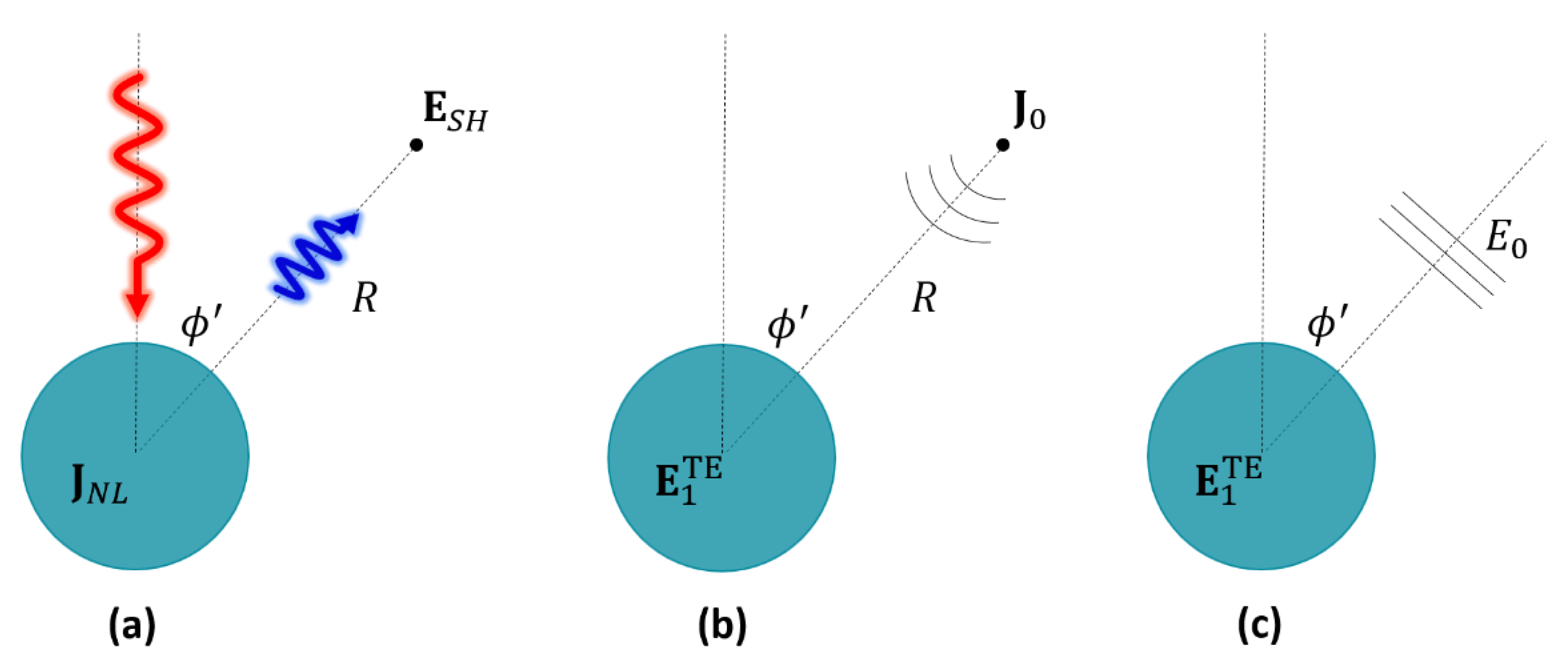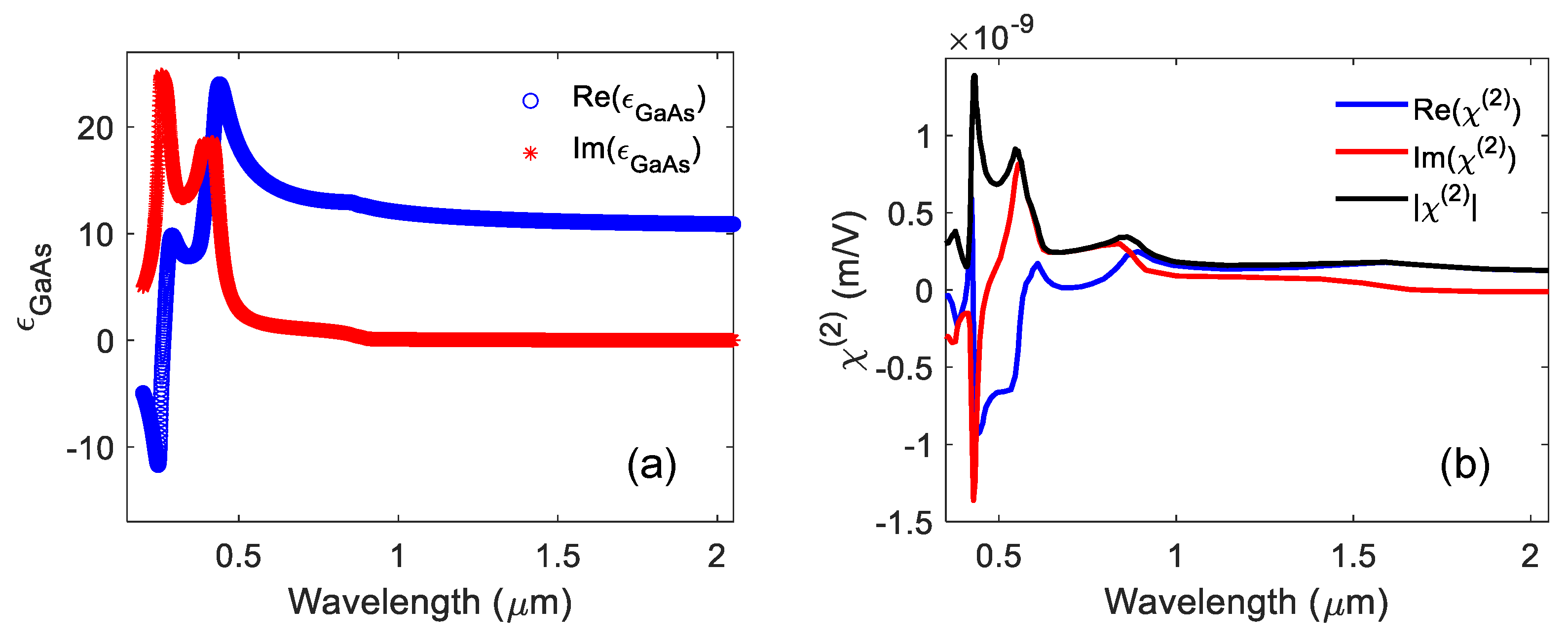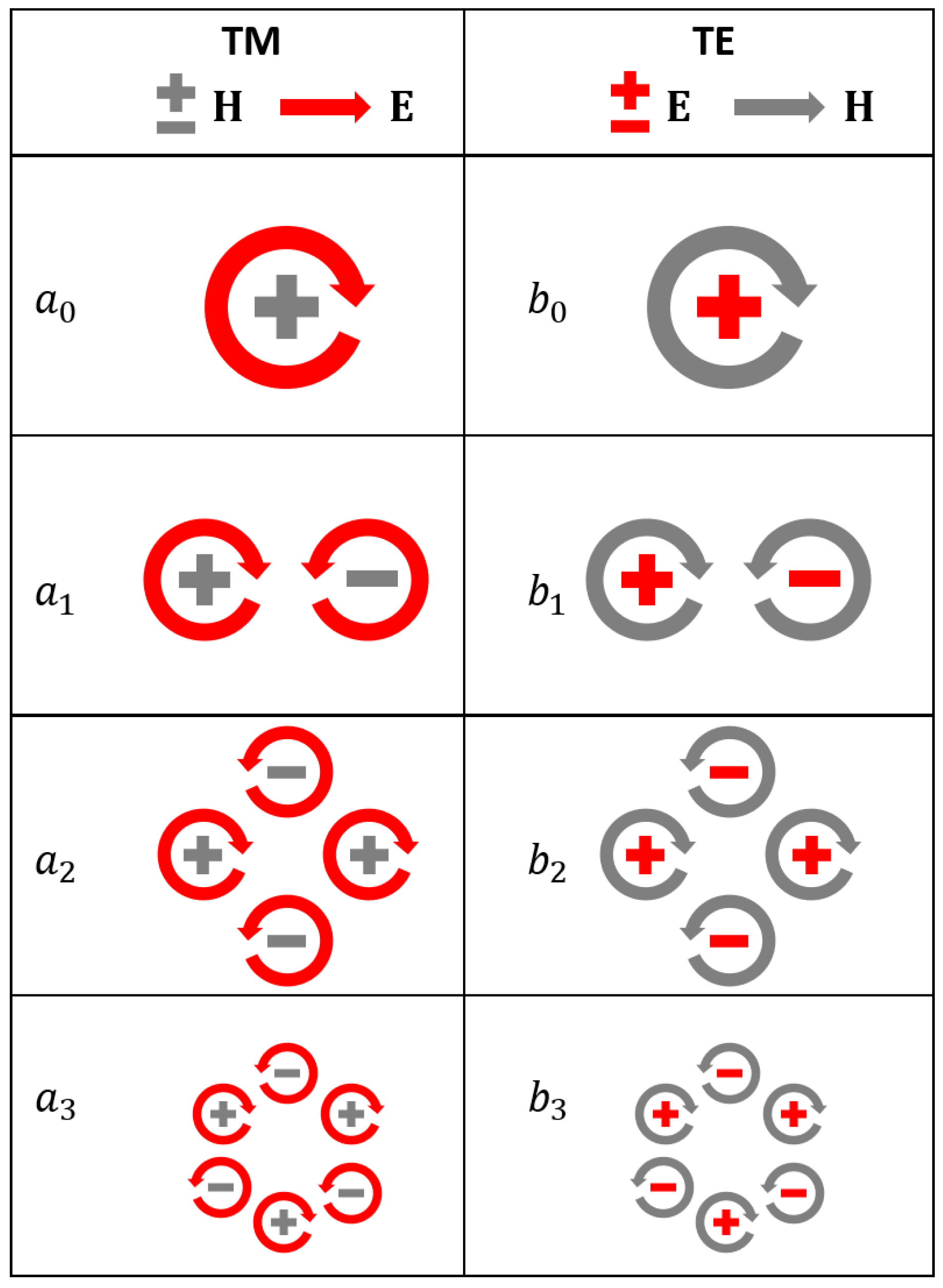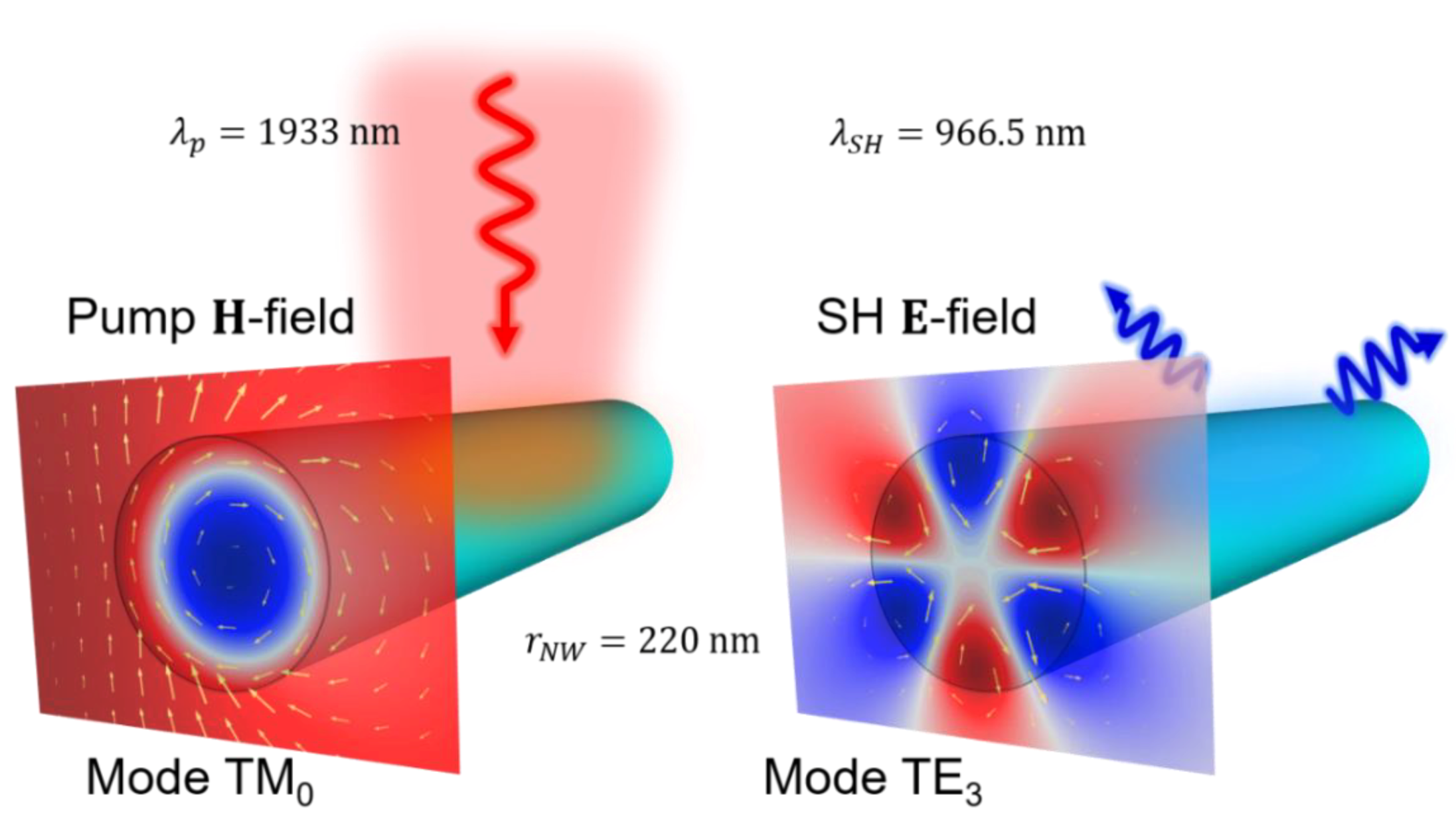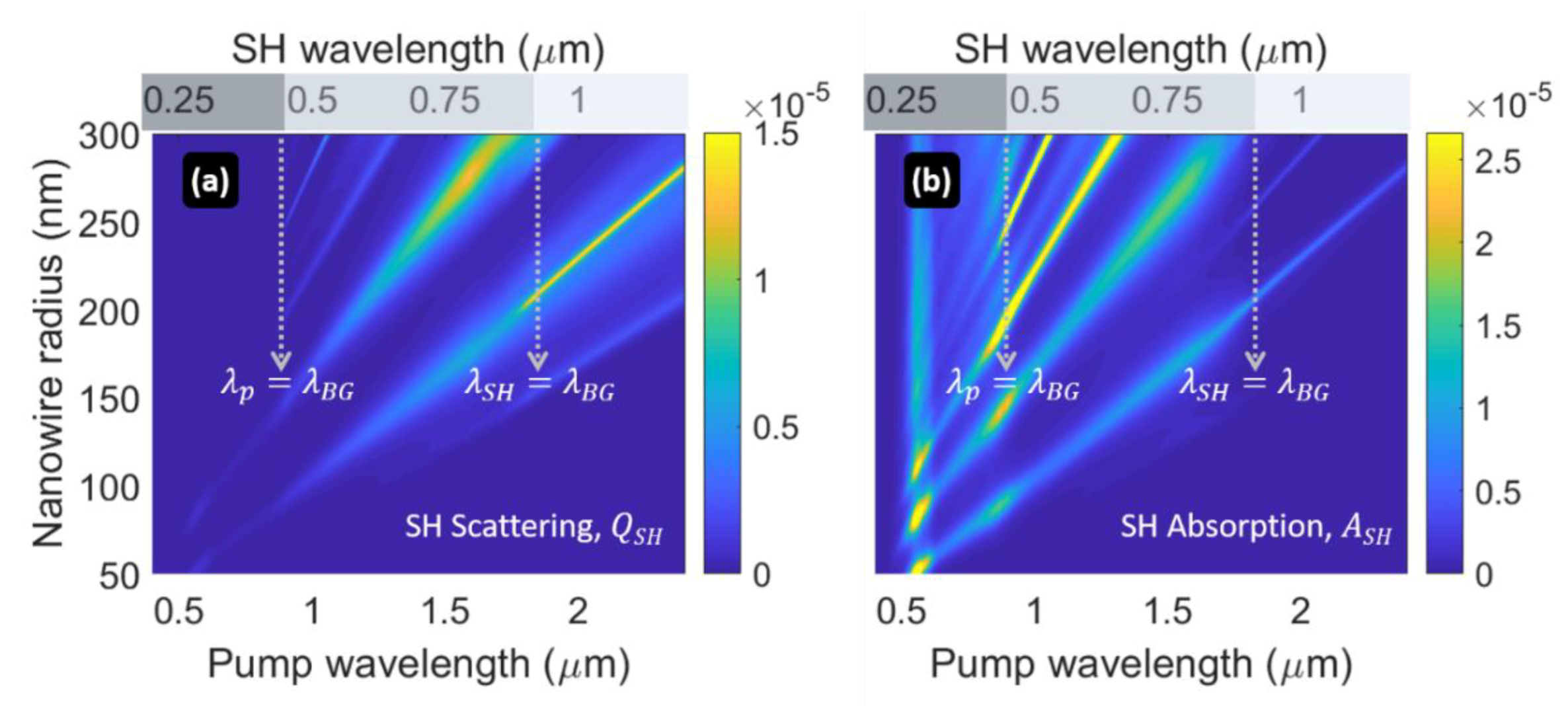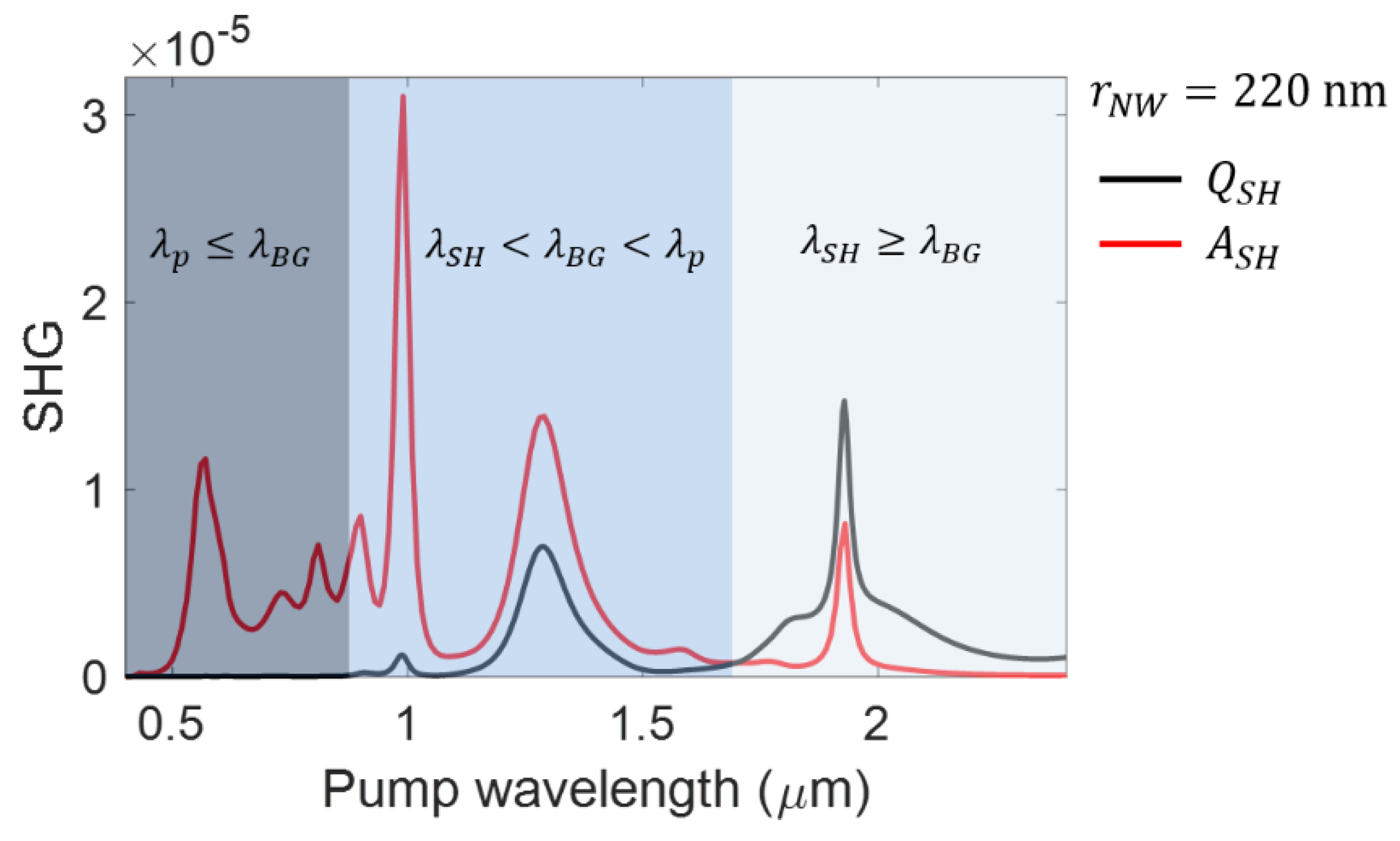1. Introduction
Optical and electronic properties of semiconductors such as Si and GaAs are suitable for the development of highly-efficient nonlinear and tunable nanophotonic devices. Semiconductors possess a high refractive index, which is a fundamental requirement to slow-down light and to increase light confinement and field-enhancement at the nano- or sub-wavelength-scale. In addition, semiconductors have low losses at telecom wavelengths, they are chemically and electrically tunable, and they show a strong nonlinear optical response from visible to far-infrared wavelengths. The bulk quadratic nonlinear response is very strong in anisotropic crystals such as GaAs [
1], in which a
effect is also present at the surface due to crystal-symmetry breaking and electric-field discontinuity [
2]. On the other hand, in isotropic crystals such as Si,
is only strong on the surface. Cubic nonlinearities are very large both in the bulk of Si and GaAs. Enhanced nonlinear optical effects have been predicted and experimentally observed in a variety of nanoscale structures based on semiconductors: At the band-edge of photonic crystals [
3,
4,
5,
6,
7], in leaky-mode-resonant gratings or photonic-crystal slabs [
8,
9,
10], and more recently in Mie-resonant nanoantennas [
11,
12] and metasurfaces [
13,
14,
15,
16]. Besides the large nonlinearity, the fabrication processes of nanoscale semiconductor devices are mature and reliable, and in some cases compatible with existing technologies for photonic integrated circuits, e.g., silicon photonics. The recent popularity gained by semiconductors in nonlinear nanophotonics is also due to the modest amount of absorption losses at telecom wavelengths, at photon energies below the electronic bandgap. Indeed, nanostructures based on semiconductors offer an all-dielectric solution for the design of nanophotonic devices with enhanced light–matter interactions [
17], and they are considered valid alternatives to plasmonic-based systems [
18], especially for nonlinear optics which require high light-intensities and, in particular, for applications in the visible and near-infrared, where metals absorb light more efficiently. It has been shown that the combination of high material nonlinearity, low absorption losses and the presence of Mie resonances in semiconductor nanoparticles creates ideal conditions to induce highly-efficient nonlinear interactions. Conversion efficiencies as high as 10
−5 for second-harmonic (SH) generation in AlGaAs nanocylinders [
13,
14] and 10
−6 for third-harmonic (TH) generation in Si nanospheres [
11] have been experimentally demonstrated by tuning the pump signal on the magnetic-dipole resonance. SH generation with record-high efficiency has been predicted in AlGaAs resonators that host bound-in-continuum states [
19]. Moreover, the possibility to tailor polarization and radiation patterns has been demonstrated for SH light scattered by AlGaAs nanocylinders [
20,
21]. The key factor to achieve strong nonlinear interactions in semiconductor nanoparticles is to couple light to Mie scattering modes [
22]. Nonlinear effects, such as SH and TH generation, have been so far investigated in isolated and arrayed Si- and GaAs-based resonant nanoparticles with three-dimensional (3D) light confinement, such as spheres and finite cylinders (nanodisks or nanopillars). Here we analyze SH generation in Mie-resonant GaAs nanowires, or infinite cylinders. Mie theory is used to describe the response in the linear regime, which is dominated by the normal modes of the nanowire. Next, an average nonlinear susceptibility, derived by the linear Mie-scattering coefficients and normal modes, is introduced to predict the far-field SH scattering efficiency and finite-element simulations are performed to calculate SH light absorption, to examine near fields, and to test the validity of the average nonlinear susceptibility. Although light is confined in only two dimensions, defined by the scattering plane orthogonal to the nanowires’ axis, we show that, if the nanowires are judiciously designed, conversion efficiencies for SH generation are similar to those achievable in nanoparticles with 3D light confinement. Finally, we discuss the role of absorption losses in SH generation, and demonstrate that: (i) Nanowires produce intense SH light even when the SH photon energy is tuned above the electronic bandgap of GaAs, where the material is opaque and it is commonly assumed that harmonic generation is not efficient, and (ii) absorption of SH light is not negligible even when the SH photon energy is tuned below the electronic bandgap of GaAs.
2. Mie Scattering in the Linear Regime and Normal Modes of GaAs Nanowires
The nanowire geometry and the electromagnetic fields have translational invariance in the direction of the nanowire axis (
axis in our coordinate system) and therefore we analyze linear and nonlinear optical scattering only in the
plane. Light is incident as a plane wave with either TM polarization (electric field parallel to the scattering
-plane) or TE polarization (electric field perpendicular to the scattering plane). We assume that the principal axes of the crystal are oriented as follows:
and
The second-order nonlinear tensor contains only elements of type
with
, so that the nonlinear current induced at the SH frequency can be written as:
where
is the pump angular frequency,
indicate the pump electric-field components, and
indicate the SH induced current components. Both the relative permittivity of GaAs,
, and the nonlinear susceptibility
are weakly dispersive at infrared wavelengths, in particular for photon energies smaller than the GaAs energy bandgap,
, where
. The frequency-dependence becomes significant at shorter wavelengths (
), where interband transitions play a non-trivial role in the spectra of SH light scattering and absorption. In
Figure 1, we plot the real and imaginary parts of
and
that we use for calculations of linear and nonlinear scattering and absorption efficiencies. Linear and nonlinear optical data are taken from [
23,
24,
25,
26], respectively. Both models account for the electronic band structure of GaAs, and therefore they include the
,
,
, and
transitions of GaAs.
Maps of scattering and absorption efficiency spectra for plane wave excitation are reported in
Figure 2 as a function of the nanowire radius. The efficiencies are calculated in the linear regime, i.e., assuming the input light intensity induces negligible nonlinear polarization sources in GaAs. Under these circumstances the problem can be approached by using Mie theory and the scattering and absorption efficiencies can be evaluated as normalized cross-sections. The normalization factor is the power (per unit length) flowing through the geometric cross-section,
, where
is the nanowire radius and
is the input light intensity [
27]. In other words, scattering efficiencies,
and absorption cross sections,
, are evaluated, for TE- and TM-polarized incident plane waves, as follows:
where
and
is the wavenumber in the background medium. In our simple geometry, with a cylindrical nanowire, the scattering coefficients for TE-polarized light scattering, i.e.,
, and TM-polarized light scattering, i.e.,
, retrieved by imposing continuity of the tangential fields at the nanowire surface, are written as follows [
27]:
where
is the nanowire index contrast,
are the Bessel functions of first kind and order
and
their derivatives, whereas
are the Hankel functions of first kind and
their derivatives.
It is worth mentioning that TE and TM problems are fully decoupled in our
-invariant structure with scattering only occurring in the
-plane. Incident, scattered and internal fields are superpositions of vector cylindrical harmonics, namely superpositions of Hankel or Bessel functions. These harmonics are the normal modes of the particle. In particular, for an incident TM-polarized plane wave with electric-field amplitude
, the scattered field outside the nanowire (
) can be written as follows:
where
is the impedance of the background medium and
the impedance in vacuo, and
are the unit vectors of a cylindrical coordinate system in which the axial coordinate,
, is aligned with the nanowire axis. By duality, for a TE-polarized plane wave the scattered field outside the nanowire is as follows:
The vector cylindrical harmonics inside the nanowire can be evaluated by substitution of
and
with
and
, respectively. For example, the TM and TE-polarized electric fields inside the nanowire can be calculated as follows:
with internal scattering coefficients:
It is clear that electric (magnetic) fields in TM polarization have the same shape and symmetry of magnetic (electric) fields in TE polarization, with the only difference being the scattering coefficients.
Figure 2 summarizes this concept.
TE light scattering only depends on the
inside the nanowire) coefficients, while TM scattering is only ruled by the
inside the nanowire) coefficients. Although the expansions in Equations (2)–(5) are valid for plane waves, it is possible to expand the fields with the same Mie coefficients in the presence of any kind of source, including SH sources induced in the volume and on the surface of the nanowire. In other words, TE(TM) scattered fields are always equal to the superposition of normal modes of an increasing order number, each weighted by the corresponding coefficient
). The normal modes of an open cavity must radiate into the far-field [
28], and therefore it is common to associate them with cartesian multipoles [
29,
30]. For example, the Mie coefficient
is related to a magnetic-dipole moment (or electric quadrupole [
29,
31]) and the associated electric field is of type
; the coefficient
is associated with a superposition of an electric dipole moment and a combination of electric-octupole moments. Higher-order coefficients
, with
are related to higher-order multipoles. TE-polarized normal modes are instead weighted by the
coefficient and they are z-polarized. The coefficient
is related to a TE mode with electric field distribution associated with an electric dipole, therefore of type
. Similarly, in the TM case, coefficients
with
are associated with higher-order modes. In
Figure 2, we summarize the electric and magnetic field distributions associated with the first four TE- and TM-polarized modes with the corresponding Mie coefficients.
In
Figure 3, we report scattering and absorption linear efficiencies, calculated with Equations (2)–(5), in response to either TE or TM polarized plane waves impinging on the nanowire. The scattering peaks are associated with the maxima of the Mie scattering coefficients, therefore, they correspond to maxima of either
for the TM case or
for the TE case—the maxima occur when the denominators of the scattering coefficients,
and
for TM polarization and
and
for TE polarization approach zero. The Mie coefficients peaks overlapped with the scattering and absorption maxima are reported in
Figure 3. On each maximum of a Mie coefficient, light is efficiently coupled to the corresponding normal mode and intensity maxima of internal near-fields and scattered far-fields are observable. For this reason, maxima of scattering and absorption are virtually overlapped. The abrupt increase of absorption cross-section above the bandgap (
) is due to the electronic transitions of GaAs. Although quenched by absorption, resonances associated with higher-order modes appear at shorter wavelengths within the visible range. It is worth noticing that the response of the nanowire is dominated by four normal modes, namely the order
and
, across the whole range of nanowire radii considered, from 50 to 300 nm, and across a broad wavelength range that covers visible and near-infrared.
3. Second-Harmonic Generation: Scattering and Absorption Efficiencies
We consider an input pump with TM polarization and intensity
. The second-order bulk response due to
will induce a TE-polarized SH signal. The normal modes available in the spectrum play a key role in determining the far-field emission efficiency and radiation pattern for SH light. We have investigated far-field SH radiation by varying the pump wavelength across the whole spectrum shown in
Figure 3. The total SH scattered efficiency is calculated in two ways: (i) By introducing an effective nonlinear susceptibility retrieved from the linear response at both the pump and SH wavelengths; (ii) with a finite-element solver (COMSOL). The SH scattering efficiency is defined as
where
is the Poynting vector at the SH wavelength in the far-field zone, and the integral is performed along a closed line surrounding the nanowire in the far-field with
being the unit vector normal to the line and pointing in the outward direction. Neglecting pump depletion and third-order nonlinear effects, it is straightforward to prove that the SH scattering efficiency shows the usual linear dependence on the pump intensity
and a simple dependence on an
average nonlinear susceptibility,
, as follows:
where
is the background impedance,
is the SH wavenumber in the background medium and the average susceptibility is calculated as the average of
, across all the possible SH scattering angles between 0 and
in the
xy plane, i.e.,
The derivation of Equation (17) is based on the Lorentz reciprocity theorem, and it is reported in the
Appendix A section. The angle-dependent, effective nonlinear coefficient,
, is related to the field enhancement at both pump and SH and to the overlap integral in the volume of the nanowire (
):
In Equation (19),
is the
field distribution in the nanowire under TM plane wave excitation at the pump frequency with amplitude
and incident at
,
is the
field distribution at the pump frequency under TM plane wave excitation with amplitude
and incident at
, and
is the
field under TE plane wave excitation at the SH frequency with amplitude
and incident
at
. The fields in Equation (19) are calculated in the linear regime and therefore they are evaluated by using the Mie-theory expressions presented in Equations (12)–(13). We have verified that truncating the cylindrical expansion of the fields in order to include only four normal modes in Equation (19) is enough to predict with good accuracy the SH scattering efficiency using the expression in Equation (17). The differences in the calculated
values with respect to the finite-element numerical simulations (COMSOL) are on the order of 1%, and they are mainly due to the order of truncation of cylindrical harmonics in the fields’ expansions. The maxima of scattering coefficients are plotted in
Figure 4 for a large range of nanowire radii next to the SH generation efficiency
map.
It is clear that the peaks in the SH scattering spectrum are associated with the excitation of nanowire modes at the pump or at the SH wavelengths, or at both wavelengths if the system is doubly-resonant. In
Figure 4, we have indicated with circles several SH peaks. In one case—see the black circle—the radius is equal to 220 nm and the pump wavelength is equal to ~1933 nm, therefore the SH is generated at 966.5 nm, in the transparency region of GaAs (
). In this scenario, the nanowire is doubly resonant for both the pump and the SH field, and this condition only occurs in a very narrow band. In particular, the pump plane wave is exciting the TM
0 mode, which is related to a broadband peak of the Mie coefficient
, whereas the SH is resonant with the mode TE
3, which is associated with a narrowband peak of the Mie coefficient
. The result of this doubly-resonant,
interaction is that SH light is scattered with high efficiency, larger than
. In
Figure 5, we plot the field distribution of the pump and SH on this peak, when the nanowire radius is
If the pump is slightly detuned from this double resonance condition, then the structure turns out to be singly-resonant with the only TM
0 mode resonantly excited by the pump and a 4-fold reduction of conversion efficiency—the dotted black circle belongs to this singly-resonant region. This explains the spectral behavior of the SH efficiency near this region, with a sharp peak (due to SH coupling to the TE
3 mode) emerging from a shallow peak (due to pump coupling to the TM
0 mode). Owing to a combination of factors, including the chromatic dispersion of GaAs as well as the dispersion of the scattering coefficients, the double resonance condition persists over a wide range of nanowire sizes, form radii smaller than 200 nm to radii larger than 300 nm. Other peaks, indicated in
Figure 4 with circles of different colors, are due to mode coupling of either the pump or SH to normal modes of the nanowire. It is remarkable that the conversion efficiency remains at similar levels, between 10
−6 and 10
−5, even in cases in which the SH wavelength,
is smaller than
and therefore absorption losses are expected to inhibit up-conversion. In particular, on the peak indicated with a red circle—corresponding to a nanowire with radius 268 nm and pumped at 1550 nm—the efficiency is as high as in the doubly resonant case, even though only the pump signal is here resonantly coupled to the TM
1 mode and the SH is tuned above the bandgap (
). The field distributions for pump and SH in this scenario are reported in
Figure 6. While the pump takes on the typical shape of a TM
1 mode, the SH is coupled to a superposition of modes, with the stronger components being the TE
1 and the TE
2, i.e., the modes associated with the
an
Mie coefficients, respectively.
4. Absorption of SH Light
The usual metrics for SH conversion efficiency involves the SH light that one may collect in a certain direction in the far-field region, or the total light scattered
in all directions in the far-field, as defined in Equation (16). However, a portion of SH energy is inexorably dissipated in the near field via one-photon absorption. The rate of this SH absorption can be calculated as follows:
can be significant in enhanced nonlinear interactions at the nanoscale. For example, in plasmonic resonators, in addition to the pump energy lost as heat in the metal, reabsorption of SH light is orders of magnitude larger than far-field scattered SH light [
32,
33,
34]. In other words,
in many nanoplasmonic systems designed to resonate at the pump and/or at the harmonic frequency. Dielectric resonators are considered immune to pump absorption if illuminated in the transparency region below the bandgap (i.e., if the pump wavelength
is larger than
), although Mie theory predicts that light absorption on the Mie resonances above the bandgap can reach values as high as 5% of the total light extinction for GaAs nanowires, as one can infer by comparing absorption maps and scattering maps in
Figure 3. In addition, a study of SH light absorption in dielectric nanoantennas (isolated or in metasurfaces) has not been reported so far, taking for granted that most of the SH light is scattered in the far-field by dielectric resonators, and not absorbed in the near field. Here we demonstrate that this is not the case, at least for nanowires with 2D light-confinement. In
Figure 7, we report a side-by-side comparison of SH scattering efficiency spectra,
, and SH absorption spectra,
, as functions of the nanowire radii.
SH scattering peaks are associated with SH absorption peaks, as in other resonant photonic structure, including plasmonic nanoantennas and gratings.
is non-negligible with respect to
. Indeed,
is on the same order or even larger than
for most resonant peaks, including those peaks that entirely fall in the transparency region of GaAs (
). These facts are summarized in
Figure 8, where the SH scattering and absorption spectra are plotted for a nanowire radius
illuminated with a TM polarized pump plane wave with intensity
. In the transparent region (
), in which GaAs is a poor absorber at both pump and SH wavelengths, scattering and absorption of SH light show similar efficiencies on the order of
on the doubly-resonant peak at
. In the intermediate wavelength range in which GaAs is mostly transparent for the pump but absorbing for the SH (
), SH absorption gets somewhat larger than SH scattering but the scattering efficiency reaches almost the same level that one has in the fully transparent region (see, e.g., the peak at
). In the opaque range (
), SH absorption dominates over scattering by at least one order of magnitude.
